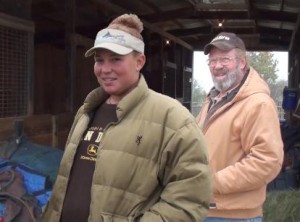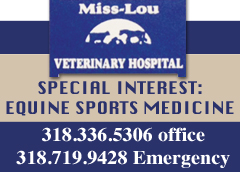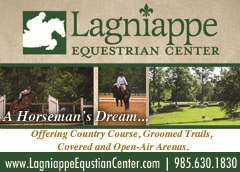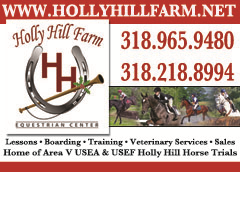Gulf Coast Equine, a full service Thoroughbred farm, is located in Sunset, just south of Opelousas, La. Owners Anna and Ray Paul stand stallions, prep horses for sales, and board and foal out mares.
Ray Paul worked for twenty-five years in the electric department of the city of Tallahassee, FL. After this “first” retirement, he entered the Thoroughbred business in Ocala. His daughter Anna grew up showing in AQHA Western Pleasure classes and absorbing her father’s Thoroughbred knowledge, as well as taking courses in equine reproduction at Central Florida Community College. Ray moved his Thoroughbred operation to Sarepta, Louisiana, from Ocala in response to incentives offered by the Louisiana Breeders Program. Sarepta is near the Arkansas border; after a few years Ray decided to move farther down the state to Sunset to be closer to potential clients.
The farm, formerly owned by Perry Judice, has a Kentucky feel. Black board fences divide the 35 acres into generous paddocks. Ninety-degree corners are few: the paddocks curve in safe, gentle arcs. Horses graze ankle-deep in the rye grass of early spring. “In the future, we’ll be subdividing the paddocks with black vinyl fencing,” says Anna. “It’s easy to put in and it is safe—especially for horses who have just come off the track.”
A large barn houses not only stalls, but also Anna’s apartment, as well as a second-story storage room filled with all the boxes that Anna hasn’t unpacked yet. Ray also lives on the property. “Somebody is here twenty-four hours a day,” says Anna. During foaling season, Anna can’t keep herself from getting up and down all night to check the mares. She uses a foal alert system, but she puts her trust in her own watchfulness.
When I meet Ray and Anna, I naturally direct some questions towards Ray—Anna, after all, is only twenty-eight, and Ray looks like “the owner”—but he doesn’t take the bait. He explains: “It’s all on Anna’s shoulders now.” Ray is committed to his third retirement. “Is your dad going to move to a beach house in the Caribbean?” Anna laughs and shakes her head. I observed him later in the day, puttering with a tractor, quite content.
We stroll by the paddocks. “Our breeding season is February 15th through June. I don’t send horses to be broke until they’re a true two-year-old. In fact, we have a three-year-old filly in training now that will make her first out at Evangeline Downs. I didn’t start her until April of her two-year-old year. We have a two-year-old colt that we probably won’t start until May.”
“You let the horse’s development tell you when to start,” I offer.
“If you do right by the horse, the horse will do right by you,” says Anna.
We admire a handsome little two-year-old colt. “He was a problem baby. That’s why I won’t break him until this May.” Anna pats him. “After we bred the owner’s mare, they shipped her out to a farm in Texas where they didn’t take care of her. She came back 300 pounds underweight, and had her foal after a year and twelve days. He was born no more than 40 pounds soaking wet. I called the owners and said, ‘This baby needs to be hospitalized.’ They said, ‘We’ve been through this before and it never turns out well. If you want the foal, you can have it; otherwise, put it down.’ I walked up to my dad and said, ‘This is my Derby horse!’”
Anna says, “He couldn’t stand up for the first three days. I held him up to nurse, and when I couldn’t hold him anymore, I’d milk the mare and feed him with a bottle. My dad swore the foal would never make it through the night. We had heating pads, electric blankets, little foal blankets.” She looks critically at the little guy. “He’s probably six months behind everyone else, but you can’t tell that there is anything wrong. He’s got Mr. Prospector and the Halo line on his mother’s side, and on his dad’s side there’s Smooth Air, from the Storm Cat line, and Deputy Minister. He’s going to stick around; he’s my kid. I named him Scoot Too because all he could do for the first few days was scoot around the stall.”
Scoot Too is a dark bay with a beautiful balanced body. “He thinks he’s a lap dog. He’s spoiled rotten!” Anna laughs. “He’ll get broke in a couple of months, and then he’ll hang out for a while doing horse things. He hasn’t finished growing yet.”
We come up to a dark bay stallion with ripped muscles. “Wow,” I say. “And look at that shoulder! Length and great slope.”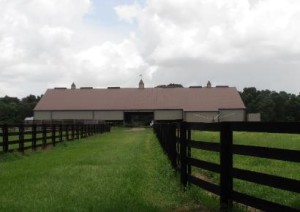
“This is Big Band Sound. He just came off the track, and this is his first year at stud.”
In the next paddock is Smooth Air. Anna tells me that he is nine years old and is an experienced breeding stallion. He no longer has that off-the-track look; he looks like he’s been enjoying his groceries, but is very fit. His bay coat is short and gleaming.
“He looks shed out already,” I say.
“No,” says Anna. “That really is his winter coat. And he refuses to wear a blanket—he takes it off and rips it up. But we keep him in a paddock. A lot of people keep their stallions in. I think, after a racing career, they’re tired of a stall. They deserve to be outside, to be a horse. They’re happier and they hold their weight better.”
Anna says, “We feed a high-fat, fourteen-per-cent pellet. Every horse has different requirements but I prefer pellets, rather than a sweet feed as they tend to digest easier. Typically we feed two times a day, more if needed. This time of year the stallions get fed three times a day, because they have to work. Each meal is two scoops of pellets with three-quarters of a scoop of beet pulp and four to five ounces of rice bran. I swear by beet pulp. Since we started feeding it, we’ve had only two horses in the past three years try to colic. Some Banamine and some walking got them out of trouble. We started with beet pulp up in Sarepta, to supplement and stretch our hay resources during those several dry years, when round bales were so expensive. We saw a considerable difference in the horses we were trying to keep weight on, especially mares with foals by their sides that are getting close to weaning. And the rice bran helps with the coat.”
Anna says that one reason a horse may be too thin after a racing career is that the horse may have been on all kinds of supplements at the track, and then the supplements were stopped when the horse stopped racing “We’ve got a mare now who’s anemic and thin. They probably took her cold turkey off of blood builders. She’s 17.1 and needs to eat four times a day. We put her back on blood builders and will wean her off gradually when her weight and health are back. She also gets half a tube of Gastrogard and a nutrition booster to help with digestion.”
We head into the barn to see the third stallion, Bob’s Proud Moment. I gasp when I see him. He’s a lanky bay, more than seventeen hands. He’s showing off in the stall, prancing and talking to anyone who will listen. Anna says that he is a grandson of Mr. Prospector, and his height comes from What a Pleasure on his dam’s side.
Anna tells the story of Bob. “He requires a lot of attention. He gets bored in the paddock, so we bring him up, groom him, put him on the walker, just to keep his mind calm. He’s the hardest to breed. He got off to a rough start on a farm out in the boonies of Florida.” Bob only bred a few mares there, and most of his first foal crop was killed by lightning while they were huddled under a tree. His owner passed away, and Bob was traded off a few times for bills owed. “And then he got lost in Miami for a while,” laughs Anna. “Well, not really lost, just not being used as a stallion.”
“The farm that first had Bob didn’t teach him right. He’s not rough with the mares; he’s rough with the handler. He’s pushy; he doesn’t respect the chain. If he starts barreling towards a mare, it’s unsafe for everyone involved. My friend Tommy Delahoussaye said he had a special halter for him. It works, and we can get the job done safely for all involved.”
Nevertheless Bob is still tough for Anna. He doesn’t like women. Anna, who is used to handling all the stallions, gave up on Bob this season and lets Justin, one of her employees, control him. “Bob and Justin get along fine. Bob just isn’t a girl’s horse…well, the feeling between us is mutual!”
Anna talks about her stallion-handling strategy. She tries to have a “we’re going to breed now” signal. She usually puts a chain through the stallion’s mouth, like a bit. The stallions learn that if that chain isn’t there, there’s no breeding.
“Big Band Sound had a tendency to bite the mare,” says Anna. “I took the throatlatch off a bridle and basically tied his mouth shut.” Over time she loosened the leather more and more; now it just hangs loosely. “The other day I brought him out without the strap, and he just stood there, looking at the mare. He didn’t talk to her or drop.” Once he had his special strap on, he was ready. “I like getting stallions as ‘freshmen’ because you can make or break them. If you get them already breeding, it’s hard to change. Big Band Sound and Smooth Air we’ve had since day one. Smooth sees you holding a halter with a chain on the lead, and he comes running up to you. He knows! He’s also talkative. He announces to the whole world that he’s going to breed a mare.”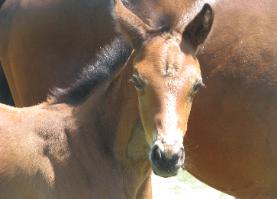
I can’t take my eyes off Bob. “If I were to breed to a Thoroughbred, this guy is the one I’d choose,” I say. “He looks like he can jump! And he has presence—he’d impress a dressage judge. ”
“He is a gorgeous mover,” says Anna. “When he extends out in the paddock, he floats. We’re going to start riding him.”
“Bob is lucky he ended up at Gulf Coast,” I say. “You are patient and you’re giving him a chance to breed good mares.”
“I come from a Quarter Horse show background,” she says. “So I like bulky studs.” Bob is the opposite of bulky; he’s a traditional Thoroughbred—he looks like he should be in an eighteenth-century painting that’s hanging in a baronial hall. But Anna says she can appreciate Bob’s looks and talent. “If it comes to that, Bob could have another job, easily. Maybe in a jumper barn.”
All Thoroughbreds must use live cover. Artificial insemination and embryo transfer are not allowed. The main reasons are economic and scientific: if AI became the norm, a few popular stallions could overwhelm the gene pool. The lack of diversity that worries Thoroughbred breeders already would become threatening. And, says Anna, artificial insemination would ruin stallion stations and mare facilities all over the nation.
Nevertheless, small-time Thoroughbred breeders have a responsibility. Anna believes that breeders must maintain quality. Just because there’s a registered Thoroughbred stallion down the road doesn’t mean your mare is going to produce a Derby winner from that mating.
We finish our tour back in the huge barn, and Anna introduces me to Bob’s friend Justin, to Dee, the exercise rider, and to her veterinarian, Dr. Brent Bonura, who has been doing pregnancy checks. The mood is easy and friendly. I notice a portable aluminum bar for serving drinks, surrounded by stools. The bar is covered with paperwork (including the Louisiana Equine Report) and has breeding records, phone books, and stallion registries stored where the bottles would be.
“We had this on the deck of our above-ground pool in Sarepta and hardly used it,” says Anna. “Now it’s sort of an office!” I can imagine mare owners relaxing with elbows on the bar, feeling the breeze through the big barn door, talking bloodlines and distances and entries.
Gulf Coast Equine has a stallion show every January, when mare owners are deciding which way to go with their breeding programs. “This year we did a big pot of gumbo, had chili and sliced ham, rolls for sandwiches, dip, the whole nine yards. It’s exciting!” I mentally make a note to angle for a 2015 invitation. I’d like to taste the gumbo…and see more of Bob.
In the distance there is a paddock with two mares and two foals. One foal, a flashy chestnut, wrestles with forelegs over at the knee and down at the pastern.
“That’s Crazy Legs. She’s five weeks old, with Flower Alley blood.” Flower Alley, a Travers Stakes winner, also sired I’ll Have Another, winner of the Kentucky Derby and the Preakness in 2012. Anna says that she and her staff have been wrapping and massaging the foal’s legs since birth. The farrier put on baby shoes with heels to help bring the pasterns up. “She’s getting lots of physical therapy, and she’s coming along.” The prognosis is good.
For a moment Anna Paul drops the calm control of a woman in a tough profession. She looks intense. “I like to fix things,” she says. She’s in the right business.
I am impressed with the effort Anna puts forth to save early foals, straighten crooked legs, and psych out stallions. Many people just wouldn’t take the time to do all that to save a horse. Gulf Coast Equine has a lot to offer and welcomes visitors and prospective clients to give them call or schedule a visit.

